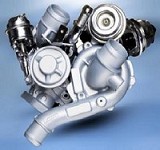|
|
|
|
TURBOCHARGER TODAY
|
|
| Home Page > Website Section Choosen > |
|
|
|
|
Like all technological instruments, turbochargers evolved due to demands and troubles experienced every day.
Basically turbos have a shape consisting of one body and two housings. This type of turbos can now be considered as most primitive. One of the important problems of these turbos is late actuation of turbine. It is not possible to obtain power by depressing the accelerator each time you require, because the wheel inside the housing starts to turn only after a certain engine revolution. This period of turbo being inactive is called Turbo Lag. Once Turbo passes this stage the vehicle experiences a sudden-kick effect and activation of turbo is surely recognized.
There are numerous ways to reduce this lag in turbo:
A- Lighter Turbochargers
As technology and material science advance, manufacturers made the alloys they use more durable and lighter. For example ceramics material inside the turbine wheel, the most important component of today’s turbocharger, makes it more resistant to temperature and lighter. Additionally the decrease in the dimensions of the turbo allows more reactionary working of wheel and compressor and leads to earlier activation. However unlike large turbos, small turbos can not create high pressures in high revolutions.
B-Use of Wastegate (Dump Valve)
Dump Valve is a part intended for increase of gas reaction by keeping turbo pressure constantly high in turbo-feed automobiles.
In Turbo-feed automobiles, turbo keeps turning when the accelerator is released; however the air pushed by turbo has nowhere to go. Therefore the resulting high pressure applies a large force on turbo wheel and instantly slows the wheel down. When you depress the accelerator again, the wheel will need accelerating for the turbo pressure reach the peak point. Here the intended turbo pressure is not achieved and a big loss in performance is encountered. Wastegate is there to prevent this performance loss.
Advantages of Wastegate
Prevents the negative reverse pressure on turbine wheel and increases the life of turbo.
Prevents the deceleration of turbine wheel and keeps turbo pressure constantly high. High turbo pressure means high power.
Old, heated air between the release and depress of accelerator is let out and fresh, cold air is taken in and extra power delivered.
C- Sequential Turbocharger (Twin Turbocharger)
 This structure, also known as twin turbo, is created by taking two housings as basis. These two turbos work side-by-side. First, the small one activates early and prevents turbo lag. Second turbo engages in high engine revolutions and essentially provides high pressure. This structure, also known as twin turbo, is created by taking two housings as basis. These two turbos work side-by-side. First, the small one activates early and prevents turbo lag. Second turbo engages in high engine revolutions and essentially provides high pressure.
Utilization of more than one small volume turbos instead of one large turbo helps the early generation of power at low engine revolutions and also is effective at high revolutions. This way available power range is also widened. These applications are generally as two turbos interconnecting with separate cylinders or synchronized working of one small and one large attached in parallel.
Alternately engaging double turbo system increases low rev torque at 1500 rpm by 36% compared to single turbo applications. This provides better performance than the electronically controlled sequential turbo unit used in Mazda RX-7 or Nissan 300 ZX models.
D- VNT-VGT (Variable Nozzle Turbo-Variable Geometry Turbo) Turbochargers
Variable turbine turbo was considered as a solution to the delayed activation of system pressure. Location of the fins on the turbine wheel is electronically adjusted by vacuum control and in order to keep the pressure high, the speed of the compressor providing power is controlled.
|
VNT Small Angle |
VNT Wide Angel
|
|
|
|
|